TPMS HONDA CR-V 2016 RM1, RM3, RM4 / 4.G Quick Guide
[x] Cancel search | Manufacturer: HONDA, Model Year: 2016, Model line: CR-V, Model: HONDA CR-V 2016 RM1, RM3, RM4 / 4.GPages: 80, PDF Size: 7.99 MB
Page 4 of 80
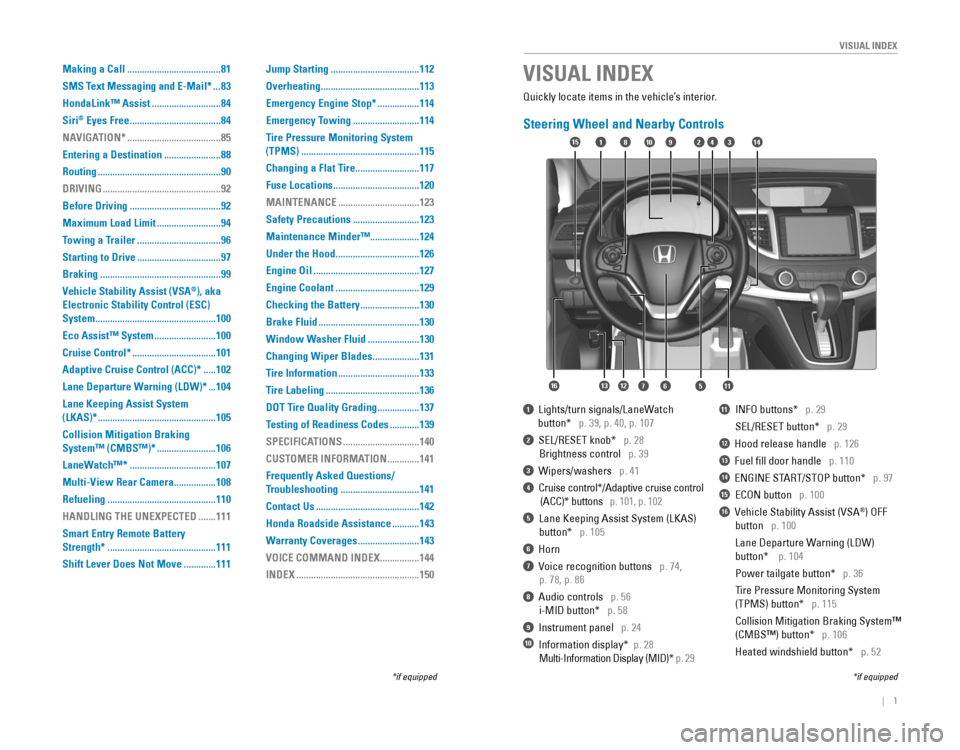
| 1
VISUAL INDEX
Quickly locate items in the vehicle’s interior.
Steering Wheel and Nearby Controls
1‚ÄÇ‚ÄÇLights/turn‚ÄÇsignals/LaneWatch
‚ÄÇ‚ÄÇ‚ÄÇ‚ÄÇ‚ÄÇ‚ÄÇbutton*‚ÄÇ‚ÄÇ‚ÄÇp.‚ÄÇ39,‚ÄÇp.‚ÄÇ40,‚ÄÇp.‚ÄÇ107
2‚ÄÇ‚ÄÇSEL/RESET‚ÄÇknob*‚ÄÇ‚ÄÇ‚ÄÇp. 28
Brightness control p. 39
3‚ÄÇ‚ÄÇWipers/washers‚ÄÇ‚ÄÇ‚ÄÇp.‚ÄÇ41
4‚ÄÇ‚ÄÇCruise‚ÄÇcontrol*/Adaptive‚ÄÇcruise‚ÄÇcontrol‚ÄÇ‚ÄÇ
‚ÄÇ(ACC)*‚ÄÇbuttons‚ÄÇ‚ÄÇ‚ÄÇp. 101, p. 102
5 Lane Keeping Assist System (LKAS)
‚ÄÇbutton* p. 105
6 Horn
7‚ÄÇ‚ÄÇVoice‚ÄÇrecognition‚ÄÇbuttons‚ÄÇ‚ÄÇ‚ÄÇp.‚ÄÇ74,
‚ÄÇp.‚ÄÇ78,‚ÄÇp.‚ÄÇ86
8 Audio controls p. 56
i-MID‚ÄÇbutton*‚ÄÇ‚ÄÇ‚ÄÇp. 58
9‚ÄÇ‚ÄÇInstrument‚ÄÇpanel‚ÄÇ‚ÄÇ‚ÄÇp.‚ÄÇ24
10‚ÄÇ‚ÄÇInformation‚ÄÇdisplay*‚ÄÇ‚ÄÇp. 28
‚ÄÇMulti-Information‚ÄÇDisplay‚ÄÇ(MID)*‚ÄÇp. 29
11‚ÄÇ‚ÄÇ‚ÄÇINFO‚ÄÇbuttons*‚ÄÇ‚ÄÇ‚ÄÇp. 29
SEL/RESET‚ÄÇbutton*‚ÄÇ‚ÄÇ‚ÄÇp. 29
12 Hood release handle p. 126
13 Fuel fill door handle p. 110
14‚ÄÇ‚ÄÇENGINE‚ÄÇSTART/STOP‚ÄÇbutton*‚ÄÇ‚ÄÇ‚ÄÇp.‚ÄÇ97
15 ECON‚ÄÇbutton p. 100
16  Vehicle Stability Assist (VSA®) OFF
‚ÄÇbutton‚ÄÇ‚ÄÇ‚ÄÇp. 100
‚ÄÇLane‚ÄÇDeparture‚ÄÇWarning‚ÄÇ(LDW)‚ÄÇ‚ÄÇ ‚ÄÇ
‚ÄÇbutton*‚ÄÇ‚ÄÇ‚ÄÇ‚ÄÇp.‚ÄÇ104
‚ÄÇPower‚ÄÇtailgate‚ÄÇbutton*‚ÄÇ‚ÄÇ‚ÄÇp. 36
Tire Pressure Monitoring System
‚ÄÇ(TPMS)‚ÄÇbutton*‚ÄÇ‚ÄÇ‚ÄÇp. 115
Collision Mitigation Braking System‚Ñ¢
‚ÄÇ(CMBS‚Ñ¢)‚ÄÇbutton*‚ÄÇ‚ÄÇ‚ÄÇp. 106
‚ÄÇHeated‚ÄÇwindshield‚ÄÇbutton*‚ÄÇ‚ÄÇ‚ÄÇp. 52
VISUAL INDEX
*if‚ÄÇequipped*if‚ÄÇequipped
92
567111213
1815341014
16
Making a Call ......................................81
SMS Text Messaging and E-Mail*
...83
HondaLink‚Ñ¢ Assist
............................84
Siri
® Eyes Free .....................................84
NAVIGATION*
......................................85
Entering a Destination
.......................88
Routing
..................................................90
DRIVING
................................................92
Before Driving
.....................................92
Maximum Load Limit
..........................94
Towing a Trailer
..................................96
Starting to Drive
..................................97
Braking
.................................................99
Vehicle Stability Assist (VSA
®), aka
Electronic Stability Control (ESC)
System
.................................................100
Eco Assist‚Ñ¢ System
.........................100
Cruise Control*
..................................101
Adaptive Cruise Control (ACC)*
.....102
Lane Departure Warning (LDW)*
...104
Lane Keeping Assist System
(LKAS)*
................................................105
Collision Mitigation Braking
System‚Ñ¢ (CMBS‚Ñ¢)*
........................106
LaneWatch‚Ñ¢*
...................................107
Multi-View Rear Camera
.................108
Refueling
............................................110
HANDLING THE UNEXPECTED
.......111
Smart Entry Remote Battery
Strength*
............................................111
Shift Lever Does Not Move
.............111 Jump Starting
....................................112
Overheating
........................................113
Emergency Engine Stop*
.................114
Emergency Towing
...........................114
Tire Pressure Monitoring System
(TPMS)
................................................115
Changing a Flat Tire
..........................117
Fuse Locations
...................................120
MAINTENANCE
.................................123
Safety Precautions
...........................123
Maintenance Minder‚Ñ¢ ....................124
Under the Hood
..................................126
Engine Oil
...........................................127
Engine Coolant
..................................129
Checking the Battery
........................130
Brake Fluid
.........................................130
Window Washer Fluid
.....................130
Changing Wiper Blades
...................131
Tire Information
.................................133
Tire Labeling
......................................136
DOT Tire Quality Grading
.................137
Testing of Readiness Codes
............139
SPECIFICATIONS
...............................140
CUSTOMER INFORMATION
.............141
Frequently Asked Questions/
Troubleshooting
................................141
Contact Us
..........................................142
Honda Roadside Assistance
...........143
Warranty Coverages
.........................143
VOICE COMMAND INDEX
................144
INDEX
..................................................150
Page 16 of 80
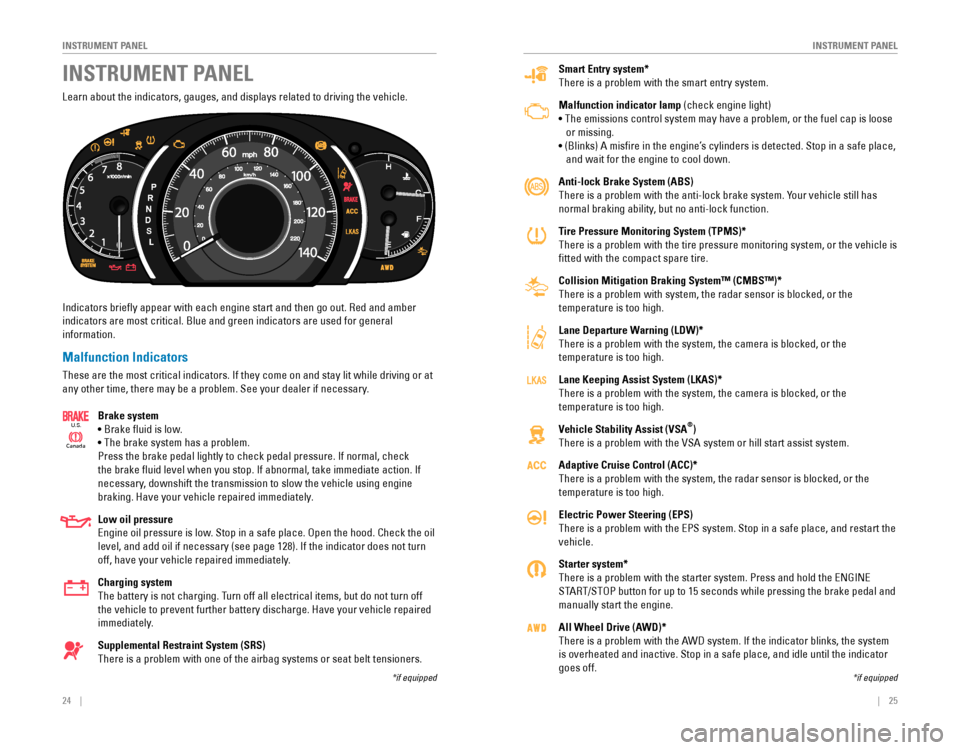
24‚ÄÇ‚ÄÇ‚ÄÇ‚ÄÇ|| 25
I
NSTRUMENT PANELINSTRUMENT PANEL
Smart Entry system*
There‚ÄÇis‚ÄÇa‚ÄÇproblem‚ÄÇwith‚ÄÇthe‚ÄÇsmart‚ÄÇentry‚ÄÇsystem.
Malfunction indicator lamp (check engine light)
• The emissions control system may have a problem, or the fuel cap is loose  
or missing.
• (Blinks) A misfire in the engine’s cylinders is detected. Stop in a safe place, 
and wait for the engine to cool down.
Anti-lock Brake System (ABS)
There‚ÄÇis‚ÄÇa‚ÄÇproblem‚ÄÇwith‚ÄÇthe‚ÄÇanti-lock‚ÄÇbrake‚ÄÇsystem.‚ÄÇYour‚ÄÇvehicle‚ÄÇstill‚ÄÇhas‚ÄÇ
normal‚ÄÇbraking‚ÄÇability,‚ÄÇbut‚ÄÇno‚ÄÇanti-lock‚ÄÇfunction.‚ÄÇ
Tire Pressure Monitoring System (TPMS)*
There‚ÄÇis‚ÄÇa‚ÄÇproblem‚ÄÇwith‚ÄÇthe‚ÄÇtire‚ÄÇpressure‚ÄÇmonitoring‚ÄÇsystem,‚ÄÇor‚ÄÇthe‚ÄÇvehicle‚ÄÇis‚ÄÇ
fitted with the compact spare tire.
Collision Mitigation Braking System‚Ñ¢ (CMBS‚Ñ¢)*
There‚ÄÇis‚ÄÇa‚ÄÇproblem‚ÄÇwith‚ÄÇsystem,‚ÄÇthe‚ÄÇradar‚ÄÇsensor‚ÄÇis‚ÄÇblocked,‚ÄÇor‚ÄÇthe‚ÄÇ
temperature is too high.
Lane Departure Warning (LDW)*
There‚ÄÇis‚ÄÇa‚ÄÇproblem‚ÄÇwith‚ÄÇthe‚ÄÇsystem,‚ÄÇthe‚ÄÇcamera‚ÄÇis‚ÄÇblocked,‚ÄÇor‚ÄÇthe‚ÄÇ
temperature is too high.
Lane Keeping Assist System (LKAS)*
There‚ÄÇis‚ÄÇa‚ÄÇproblem‚ÄÇwith‚ÄÇthe‚ÄÇsystem,‚ÄÇthe‚ÄÇcamera‚ÄÇis‚ÄÇblocked,‚ÄÇor‚ÄÇthe‚ÄÇ
temperature is too high.
Vehicle Stability Assist (VSA
®)
There‚ÄÇis‚ÄÇa‚ÄÇproblem‚ÄÇwith‚ÄÇthe‚ÄÇVSA‚ÄÇsystem‚ÄÇor‚ÄÇhill‚ÄÇstart‚ÄÇassist‚ÄÇsystem.
Adaptive Cruise Control (ACC)*
There‚ÄÇis‚ÄÇa‚ÄÇproblem‚ÄÇwith‚ÄÇthe‚ÄÇsystem,‚ÄÇthe‚ÄÇradar‚ÄÇsensor‚ÄÇis‚ÄÇblocked,‚ÄÇor‚ÄÇthe‚ÄÇ
temperature is too high.
Electric Power Steering (EPS)
There‚ÄÇis‚ÄÇa‚ÄÇproblem‚ÄÇwith‚ÄÇthe‚ÄÇEPS‚ÄÇsystem.‚ÄÇStop‚ÄÇin‚ÄÇa‚ÄÇsafe‚ÄÇplace,‚ÄÇand‚ÄÇrestart‚ÄÇthe‚ÄÇ
vehicle.
Starter system*
There‚ÄÇis‚ÄÇa‚ÄÇproblem‚ÄÇwith‚ÄÇthe‚ÄÇstarter‚ÄÇsystem.‚ÄÇPress‚ÄÇand‚ÄÇhold‚ÄÇthe‚ÄÇENGINE‚ÄÇ
START/STOP‚ÄÇbutton‚ÄÇfor‚ÄÇup‚ÄÇto‚ÄÇ15‚ÄÇseconds‚ÄÇwhile‚ÄÇpressing‚ÄÇthe‚ÄÇbrake‚ÄÇpedal‚ÄÇand‚ÄÇ
manually start the engine.
All Wheel Drive (AWD)*
There‚ÄÇis‚ÄÇa‚ÄÇproblem‚ÄÇwith‚ÄÇthe‚ÄÇAWD‚ÄÇsystem.‚ÄÇIf‚ÄÇthe‚ÄÇindicator‚ÄÇblinks,‚ÄÇthe‚ÄÇsystem‚ÄÇ
is overheated and inactive. Stop in a safe place, and idle until the ind\
icator
goes off.
Learn‚ÄÇabout‚ÄÇthe‚ÄÇindicators,‚ÄÇgauges,‚ÄÇand‚ÄÇdisplays‚ÄÇrelated‚ÄÇto‚ÄÇdriving‚ÄÇthe‚ÄÇvehicle.
Indicators‚ÄÇbriefly‚ÄÇappear‚ÄÇwith‚ÄÇeach‚ÄÇengine‚ÄÇstart‚ÄÇand‚ÄÇthen‚ÄÇgo‚ÄÇout.‚ÄÇRed‚ÄÇand‚ÄÇamber‚ÄÇ
indicators are most critical. Blue and green indicators are used for general?
information.
Malfunction Indicators
These‚ÄÇare‚ÄÇthe‚ÄÇmost‚ÄÇcritical‚ÄÇindicators.‚ÄÇIf‚ÄÇthey‚ÄÇcome‚ÄÇon‚ÄÇand‚ÄÇstay‚ÄÇlit‚ÄÇwhile‚ÄÇdriving‚ÄÇor‚ÄÇat‚ÄÇ
any‚ÄÇother‚ÄÇtime,‚ÄÇthere‚ÄÇmay‚ÄÇbe‚ÄÇa‚ÄÇproblem.‚ÄÇSee‚ÄÇyour‚ÄÇdealer‚ÄÇif‚ÄÇnecessary.
Brake system
• Brake fluid is low.
• The brake system has a problem.
Press‚ÄÇthe‚ÄÇbrake‚ÄÇpedal‚ÄÇlightly‚ÄÇto‚ÄÇcheck‚ÄÇpedal‚ÄÇpressure.‚ÄÇIf‚ÄÇnormal,‚ÄÇcheck‚ÄÇ
the‚ÄÇbrake‚ÄÇfluid‚ÄÇlevel‚ÄÇwhen‚ÄÇyou‚ÄÇstop.‚ÄÇIf‚ÄÇabnormal,‚ÄÇtake‚ÄÇimmediate‚ÄÇaction.‚ÄÇIf‚ÄÇ
necessary, downshift the transmission to slow the vehicle using engine
braking.‚ÄÇHave‚ÄÇyour‚ÄÇvehicle‚ÄÇrepaired‚ÄÇimmediately.
Low oil pressure
Engine‚ÄÇoil‚ÄÇpressure‚ÄÇis‚ÄÇlow.‚ÄÇStop‚ÄÇin‚ÄÇa‚ÄÇsafe‚ÄÇplace.‚ÄÇOpen‚ÄÇthe‚ÄÇhood.‚ÄÇCheck‚ÄÇthe‚ÄÇoil‚ÄÇ
level,‚ÄÇand‚ÄÇadd‚ÄÇoil‚ÄÇif‚ÄÇnecessary‚ÄÇ(see‚ÄÇpage‚ÄÇ128).‚ÄÇIf‚ÄÇthe‚ÄÇindicator‚ÄÇdoes‚ÄÇnot‚ÄÇturn‚ÄÇ
off, have your vehicle repaired immediately.
Charging system
The‚ÄÇbattery‚ÄÇis‚ÄÇnot‚ÄÇcharging.‚ÄÇTurn‚ÄÇoff‚ÄÇall‚ÄÇelectrical‚ÄÇitems,‚ÄÇbut‚ÄÇdo‚ÄÇnot‚ÄÇturn‚ÄÇoff‚ÄÇ
the‚ÄÇvehicle‚ÄÇto‚ÄÇprevent‚ÄÇfurther‚ÄÇbattery‚ÄÇdischarge.‚ÄÇHave‚ÄÇyour‚ÄÇvehicle‚ÄÇrepaired‚ÄÇ
immediately.
Supplemental Restraint System (SRS)
There‚ÄÇis‚ÄÇa‚ÄÇproblem‚ÄÇwith‚ÄÇone‚ÄÇof‚ÄÇthe‚ÄÇairbag‚ÄÇsystems‚ÄÇor‚ÄÇseat‚ÄÇbelt‚ÄÇtensioners.‚ÄÇ
Ca nada
U.S.
INSTRUMENT PANEL
*if‚ÄÇequipped*if‚ÄÇequipped
Page 61 of 80
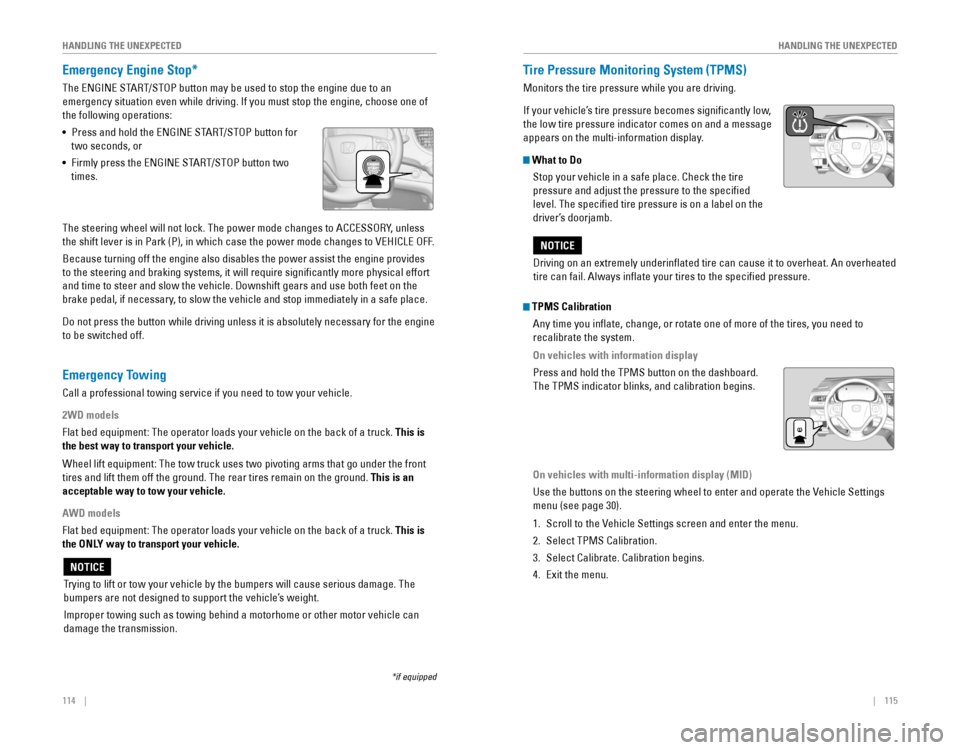
114‚ÄÇ‚ÄÇ‚ÄÇ‚ÄÇ|| 115
HANDLING THE UNEXPECTED
HANDLING THE UNEXPECTED
Emergency Engine Stop*
The‚ÄÇENGINE‚ÄÇSTART/STOP‚ÄÇbutton‚ÄÇmay‚ÄÇbe‚ÄÇused‚ÄÇto‚ÄÇstop‚ÄÇthe‚ÄÇengine‚ÄÇdue‚ÄÇto‚ÄÇan‚ÄÇ
emergency‚ÄÇsituation‚ÄÇeven‚ÄÇwhile‚ÄÇdriving.‚ÄÇIf‚ÄÇyou‚ÄÇmust‚ÄÇstop‚ÄÇthe‚ÄÇengine,‚ÄÇchoose‚ÄÇone‚ÄÇof‚ÄÇ
the following operations:
• 
Press‚ÄÇand‚ÄÇhold‚ÄÇthe‚ÄÇENGINE‚ÄÇSTART/STOP‚ÄÇbutton‚ÄÇfor‚ÄÇ
two seconds, or
• 
Firmly‚ÄÇpress‚ÄÇthe‚ÄÇENGINE‚ÄÇSTART/STOP‚ÄÇbutton‚ÄÇtwo‚ÄÇ
times.
The‚ÄÇsteering‚ÄÇwheel‚ÄÇwill‚ÄÇnot‚ÄÇlock.‚ÄÇThe‚ÄÇpower‚ÄÇmode‚ÄÇchanges‚ÄÇto‚ÄÇACCESSORY,‚ÄÇunless‚ÄÇ
the‚ÄÇshift‚ÄÇlever‚ÄÇis‚ÄÇin‚ÄÇPark‚ÄÇ(P),‚ÄÇin‚ÄÇwhich‚ÄÇcase‚ÄÇthe‚ÄÇpower‚ÄÇmode‚ÄÇchanges‚ÄÇto‚ÄÇVEHICLE‚ÄÇOFF.
Because‚ÄÇturning‚ÄÇoff‚ÄÇthe‚ÄÇengine‚ÄÇalso‚ÄÇdisables‚ÄÇthe‚ÄÇpower‚ÄÇassist‚ÄÇthe‚ÄÇengine‚ÄÇprovides‚ÄÇ
to‚ÄÇthe‚ÄÇsteering‚ÄÇand‚ÄÇbraking‚ÄÇsystems,‚ÄÇit‚ÄÇwill‚ÄÇrequire‚ÄÇsignificantly‚ÄÇmore‚ÄÇphysical‚ÄÇeffort‚ÄÇ
and‚ÄÇtime‚ÄÇto‚ÄÇsteer‚ÄÇand‚ÄÇslow‚ÄÇthe‚ÄÇvehicle.‚ÄÇDownshift‚ÄÇgears‚ÄÇand‚ÄÇuse‚ÄÇboth‚ÄÇfeet‚ÄÇon‚ÄÇthe‚ÄÇ
brake‚ÄÇpedal,‚ÄÇif‚ÄÇnecessary,‚ÄÇto‚ÄÇslow‚ÄÇthe‚ÄÇvehicle‚ÄÇand‚ÄÇstop‚ÄÇimmediately‚ÄÇin‚ÄÇa‚ÄÇsafe‚ÄÇplace.
Do‚ÄÇnot‚ÄÇpress‚ÄÇthe‚ÄÇbutton‚ÄÇwhile‚ÄÇdriving‚ÄÇunless‚ÄÇit‚ÄÇis‚ÄÇabsolutely‚ÄÇnecessary‚ÄÇfor‚ÄÇthe‚ÄÇengine‚ÄÇ
to‚ÄÇbe‚ÄÇswitched‚ÄÇoff.
*if‚ÄÇequipped
Trying‚ÄÇto‚ÄÇlift‚ÄÇor‚ÄÇtow‚ÄÇyour‚ÄÇvehicle‚ÄÇby‚ÄÇthe‚ÄÇbumpers‚ÄÇwill‚ÄÇcause‚ÄÇserious‚ÄÇdamage.‚ÄÇThe‚ÄÇ
bumpers are not designed to support the vehicle’s weight.
Improper‚ÄÇtowing‚ÄÇsuch‚ÄÇas‚ÄÇtowing‚ÄÇbehind‚ÄÇa‚ÄÇmotorhome‚ÄÇor‚ÄÇother‚ÄÇmotor‚ÄÇvehicle‚ÄÇcan‚ÄÇ
damage the transmission.
NOTICE
Tire Pressure Monitoring System (TPMS)
Monitors the tire pressure while you are driving.
If your vehicle’s tire pressure becomes significantly low, 
the low tire pressure indicator comes on and a message
appears on the multi-information display.
What to Do Stop your vehicle in a safe place. Check the tire
pressure and adjust the pressure to the specified
level.‚ÄÇThe‚ÄÇspecified‚ÄÇtire‚ÄÇpressure‚ÄÇis‚ÄÇon‚ÄÇa‚ÄÇlabel‚ÄÇon‚ÄÇthe‚ÄÇ
driver’s doorjamb.
Emergency Towing
Call a professional towing service if you need to tow your vehicle.
2WD models
Flat‚ÄÇbed‚ÄÇequipment:‚ÄÇThe‚ÄÇoperator‚ÄÇloads‚ÄÇyour‚ÄÇvehicle‚ÄÇon‚ÄÇthe‚ÄÇback‚ÄÇof‚ÄÇa‚ÄÇtruck.‚ÄÇThis is
the best way to transport your vehicle.
Wheel‚ÄÇlift‚ÄÇequipment:‚ÄÇThe‚ÄÇtow‚ÄÇtruck‚ÄÇuses‚ÄÇtwo‚ÄÇpivoting‚ÄÇarms‚ÄÇthat‚ÄÇgo‚ÄÇunder‚ÄÇthe‚ÄÇfront‚ÄÇ
tires and lift them off the ground. The rear tires remain on the ground.\
This is an
acceptable way to tow your vehicle.
AWD models
Flat‚ÄÇbed‚ÄÇequipment:‚ÄÇThe‚ÄÇoperator‚ÄÇloads‚ÄÇyour‚ÄÇvehicle‚ÄÇon‚ÄÇthe‚ÄÇback‚ÄÇof‚ÄÇa‚ÄÇtruck.‚ÄÇThis is
the ONLY way to transport your vehicle.
Driving‚ÄÇon‚ÄÇan‚ÄÇextremely‚ÄÇunderinflated‚ÄÇtire‚ÄÇcan‚ÄÇcause‚ÄÇit‚ÄÇto‚ÄÇoverheat.‚ÄÇAn‚ÄÇoverheated‚ÄÇ
tire can fail. Always inflate your tires to the specified pressure.
NOTICE
TPMS Calibration
Any time you inflate, change, or rotate one of more of the tires, you \
need to
recalibrate‚ÄÇthe‚ÄÇsystem.
On vehicles with information display
Press‚ÄÇand‚ÄÇhold‚ÄÇthe‚ÄÇTPMS‚ÄÇbutton‚ÄÇon‚ÄÇthe‚ÄÇdashboard.‚ÄÇ
The‚ÄÇTPMS‚ÄÇindicator‚ÄÇblinks,‚ÄÇand‚ÄÇcalibration‚ÄÇbegins.
On vehicles with multi-information display (MID)
Use‚ÄÇthe‚ÄÇbuttons‚ÄÇon‚ÄÇthe‚ÄÇsteering‚ÄÇwheel‚ÄÇto‚ÄÇenter‚ÄÇand‚ÄÇoperate‚ÄÇthe‚ÄÇVehicle‚ÄÇSettings‚ÄÇ
menu (see page 30).
1. Scroll to the Vehicle Settings screen and enter the menu.
2. Select‚ÄÇTPMS‚ÄÇCalibration.
3. Select‚ÄÇCalibrate.‚ÄÇCalibration‚ÄÇbegins.
4.‚ÄÇExit‚ÄÇthe‚ÄÇmenu.
Page 62 of 80
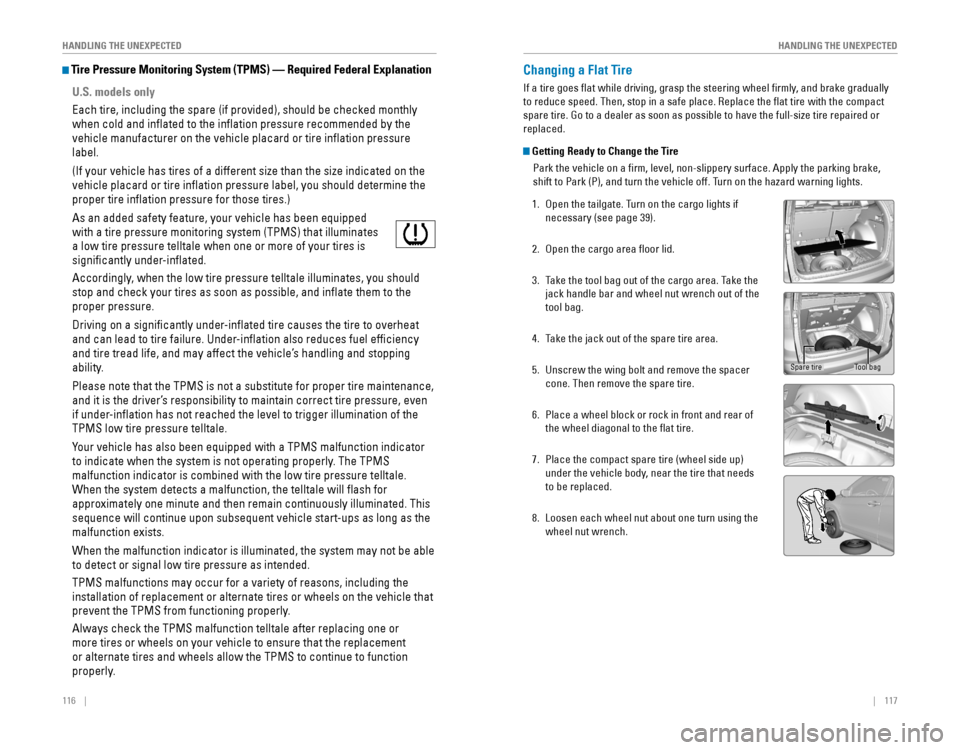
116 ||‚ÄÇ‚ÄÇ‚ÄÇ‚ÄÇ117
HANDLING THE UNEXPECTED
HANDLING THE UNEXPECTED
Tire Pressure Monitoring System (TPMS) — Required Federal Explanatio\
n
U.S. models only
Each‚ÄÇtire,‚ÄÇincluding‚ÄÇthe‚ÄÇspare‚ÄÇ(if‚ÄÇprovided),‚ÄÇshould‚ÄÇbe‚ÄÇchecked‚ÄÇmonthly‚ÄÇ
when‚ÄÇcold‚ÄÇand‚ÄÇinflated‚ÄÇto‚ÄÇthe‚ÄÇinflation‚ÄÇpressure‚ÄÇrecommended‚ÄÇby‚ÄÇthe‚ÄÇ
vehicle manufacturer on the vehicle placard or tire inflation pressure\
label.
(If‚ÄÇyour‚ÄÇvehicle‚ÄÇhas‚ÄÇtires‚ÄÇof‚ÄÇa‚ÄÇdifferent‚ÄÇsize‚ÄÇthan‚ÄÇthe‚ÄÇsize‚ÄÇindicated‚ÄÇon‚ÄÇthe‚ÄÇ
vehicle‚ÄÇplacard‚ÄÇor‚ÄÇtire‚ÄÇinflation‚ÄÇpressure‚ÄÇlabel,‚ÄÇyou‚ÄÇshould‚ÄÇdetermine‚ÄÇthe‚ÄÇ
proper tire inflation pressure for those tires.)
As‚ÄÇan‚ÄÇadded‚ÄÇsafety‚ÄÇfeature,‚ÄÇyour‚ÄÇvehicle‚ÄÇhas‚ÄÇbeen‚ÄÇequipped‚ÄÇ
with a tire pressure monitoring system (TPMS) that illuminates
a low tire pressure telltale when one or more of your tires is
significantly under-inflated.
Accordingly, when the low tire pressure telltale illuminates, you should
stop‚ÄÇand‚ÄÇcheck‚ÄÇyour‚ÄÇtires‚ÄÇas‚ÄÇsoon‚ÄÇas‚ÄÇpossible,‚ÄÇand‚ÄÇinflate‚ÄÇthem‚ÄÇto‚ÄÇthe‚ÄÇ
proper pressure.
Driving‚ÄÇon‚ÄÇa‚ÄÇsignificantly‚ÄÇunder-inflated‚ÄÇtire‚ÄÇcauses‚ÄÇthe‚ÄÇtire‚ÄÇto‚ÄÇoverheat‚ÄÇ
and can lead to tire failure. Under-inflation also reduces fuel efficiency
and tire tread life, and may affect the vehicle’s handling and stopping
ability.
Please‚ÄÇnote‚ÄÇthat‚ÄÇthe‚ÄÇTPMS‚ÄÇis‚ÄÇnot‚ÄÇa‚ÄÇsubstitute‚ÄÇfor‚ÄÇproper‚ÄÇtire‚ÄÇmaintenance,‚ÄÇ
and it is the driver’s responsibility to maintain correct tire pressure, even 
if under-inflation has not reached the level to trigger illumination of the
TPMS low tire pressure telltale.
Your‚ÄÇvehicle‚ÄÇhas‚ÄÇalso‚ÄÇbeen‚ÄÇequipped‚ÄÇwith‚ÄÇa‚ÄÇTPMS‚ÄÇmalfunction‚ÄÇindicator‚ÄÇ
to indicate when the system is not operating properly. The TPMS
malfunction‚ÄÇindicator‚ÄÇis‚ÄÇcombined‚ÄÇwith‚ÄÇthe‚ÄÇlow‚ÄÇtire‚ÄÇpressure‚ÄÇtelltale.‚ÄÇ
When the system detects a malfunction, the telltale will flash for
approximately one minute and then remain continuously illuminated. This \
sequence‚ÄÇwill‚ÄÇcontinue‚ÄÇupon‚ÄÇsubsequent‚ÄÇvehicle‚ÄÇstart-ups‚ÄÇas‚ÄÇlong‚ÄÇas‚ÄÇthe‚ÄÇ
malfunction exists.
When‚ÄÇthe‚ÄÇmalfunction‚ÄÇindicator‚ÄÇis‚ÄÇilluminated,‚ÄÇthe‚ÄÇsystem‚ÄÇmay‚ÄÇnot‚ÄÇbe‚ÄÇable‚ÄÇ
to detect or signal low tire pressure as intended.
TPMS malfunctions may occur for a variety of reasons, including the
installation of replacement or alternate tires or wheels on the vehicle \
that
prevent the TPMS from functioning properly.
Always check the TPMS malfunction telltale after replacing one or
more tires or wheels on your vehicle to ensure that the replacement
or alternate tires and wheels allow the TPMS to continue to function
properly.
Changing a Flat Tire
If‚ÄÇa‚ÄÇtire‚ÄÇgoes‚ÄÇflat‚ÄÇwhile‚ÄÇdriving,‚ÄÇgrasp‚ÄÇthe‚ÄÇsteering‚ÄÇwheel‚ÄÇfirmly,‚ÄÇand‚ÄÇbrake‚ÄÇgradually‚ÄÇ
to reduce speed. Then, stop in a safe place. Replace the flat tire wit\
h the compact
spare‚ÄÇtire.‚ÄÇGo‚ÄÇto‚ÄÇa‚ÄÇdealer‚ÄÇas‚ÄÇsoon‚ÄÇas‚ÄÇpossible‚ÄÇto‚ÄÇhave‚ÄÇthe‚ÄÇfull-size‚ÄÇtire‚ÄÇrepaired‚ÄÇor‚ÄÇ
replaced.
Getting Ready to Change the Tire
Park‚ÄÇthe‚ÄÇvehicle‚ÄÇon‚ÄÇa‚ÄÇfirm,‚ÄÇlevel,‚ÄÇnon-slippery‚ÄÇsurface.‚ÄÇApply‚ÄÇthe‚ÄÇparking‚ÄÇbrake,‚ÄÇ
shift‚ÄÇto‚ÄÇPark‚ÄÇ(P),‚ÄÇand‚ÄÇturn‚ÄÇthe‚ÄÇvehicle‚ÄÇoff.‚ÄÇTurn‚ÄÇon‚ÄÇthe‚ÄÇhazard‚ÄÇwarning‚ÄÇlights.
1. Open the tailgate. Turn on the cargo lights if
necessary (see page 39).
2. Open the cargo area floor lid.
3. Take‚ÄÇthe‚ÄÇtool‚ÄÇbag‚ÄÇout‚ÄÇof‚ÄÇthe‚ÄÇcargo‚ÄÇarea.‚ÄÇTake‚ÄÇthe‚ÄÇ
jack‚ÄÇhandle‚ÄÇbar‚ÄÇand‚ÄÇwheel‚ÄÇnut‚ÄÇwrench‚ÄÇout‚ÄÇof‚ÄÇthe‚ÄÇ
tool‚ÄÇbag.
4.‚ÄÇTake the jack out of the spare tire area.
5. Unscrew‚ÄÇthe‚ÄÇwing‚ÄÇbolt‚ÄÇand‚ÄÇremove‚ÄÇthe‚ÄÇspacer‚ÄÇ
cone. Then remove the spare tire.
6. Place‚ÄÇa‚ÄÇwheel‚ÄÇblock‚ÄÇor‚ÄÇrock‚ÄÇin‚ÄÇfront‚ÄÇand‚ÄÇrear‚ÄÇof‚ÄÇ
the wheel diagonal to the flat tire.
7.‚ÄÇPlace the compact spare tire (wheel side up)
under‚ÄÇthe‚ÄÇvehicle‚ÄÇbody,‚ÄÇnear‚ÄÇthe‚ÄÇtire‚ÄÇthat‚ÄÇneeds‚ÄÇ
to‚ÄÇbe‚ÄÇreplaced.
8. Loosen‚ÄÇeach‚ÄÇwheel‚ÄÇnut‚ÄÇabout‚ÄÇone‚ÄÇturn‚ÄÇusing‚ÄÇthe‚ÄÇ
wheel nut wrench.
Tool‚ÄÇbagSpare tire
Page 63 of 80
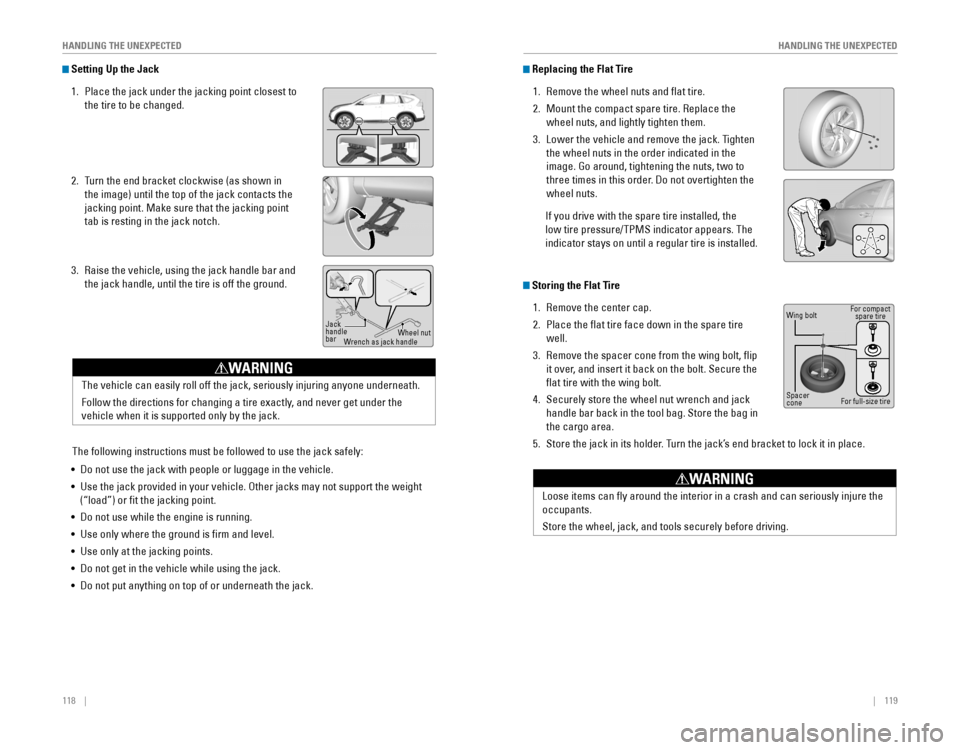
118 || 119
HANDLING THE UNEXPECTED
HANDLING THE UNEXPECTED
Setting Up the Jack
1. Place the jack under the jacking point closest to
the‚ÄÇtire‚ÄÇto‚ÄÇbe‚ÄÇchanged.
2. Turn‚ÄÇthe‚ÄÇend‚ÄÇbracket‚ÄÇclockwise‚ÄÇ(as‚ÄÇshown‚ÄÇin‚ÄÇ
the image) until the top of the jack contacts the
jacking point. Make sure that the jacking point
tab‚ÄÇis‚ÄÇresting‚ÄÇin‚ÄÇthe‚ÄÇjack‚ÄÇnotch.
3. Raise‚ÄÇthe‚ÄÇvehicle,‚ÄÇusing‚ÄÇthe‚ÄÇjack‚ÄÇhandle‚ÄÇbar‚ÄÇand‚ÄÇ
the jack handle, until the tire is off the ground.
The vehicle can easily roll off the jack, seriously injuring anyone unde\
rneath.
Follow the directions for changing a tire exactly, and never get under the
vehicle‚ÄÇwhen‚ÄÇit‚ÄÇis‚ÄÇsupported‚ÄÇonly‚ÄÇby‚ÄÇthe‚ÄÇjack.
WARNING
Jack
handle
bar Wheel nut
Wrench as jack handle
The‚ÄÇfollowing‚ÄÇinstructions‚ÄÇmust‚ÄÇbe‚ÄÇfollowed‚ÄÇto‚ÄÇuse‚ÄÇthe‚ÄÇjack‚ÄÇsafely:
• Do not use the jack with people or luggage in the vehicle.
•  Use the jack provided in your vehicle. Other jacks may not support the w\
eight
(“load”) or fit the jacking point.
• 
Do‚ÄÇnot‚ÄÇuse‚ÄÇwhile‚ÄÇthe‚ÄÇengine‚ÄÇis‚ÄÇrunning.
•  Use only where the ground is firm and level.
•  Use only at the jacking points.
• 
Do‚ÄÇnot‚ÄÇget‚ÄÇin‚ÄÇthe‚ÄÇvehicle‚ÄÇwhile‚ÄÇusing‚ÄÇthe‚ÄÇjack.
• Do not put anything on top of or underneath the jack.
Replacing the Flat Tire
1. Remove the wheel nuts and flat tire.
2. Mount the compact spare tire. Replace the
wheel nuts, and lightly tighten them.
3. Lower the vehicle and remove the jack. Tighten
the wheel nuts in the order indicated in the
image. Go around, tightening the nuts, two to
three‚ÄÇtimes‚ÄÇin‚ÄÇthis‚ÄÇorder.‚ÄÇDo‚ÄÇnot‚ÄÇovertighten‚ÄÇthe‚ÄÇ
wheel nuts.
If‚ÄÇyou‚ÄÇdrive‚ÄÇwith‚ÄÇthe‚ÄÇspare‚ÄÇtire‚ÄÇinstalled,‚ÄÇthe‚ÄÇ
low‚ÄÇtire‚ÄÇpressure/TPMS‚ÄÇindicator‚ÄÇappears.‚ÄÇThe‚ÄÇ
indicator stays on until a regular tire is installed.
Loose items can fly around the interior in a crash and can seriously i\
njure the
occupants.
Store‚ÄÇthe‚ÄÇwheel,‚ÄÇjack,‚ÄÇand‚ÄÇtools‚ÄÇsecurely‚ÄÇbefore‚ÄÇdriving.
WARNING
Storing the Flat Tire
1. Remove the center cap.
2. Place the flat tire face down in the spare tire
well.
3. Remove‚ÄÇthe‚ÄÇspacer‚ÄÇcone‚ÄÇfrom‚ÄÇthe‚ÄÇwing‚ÄÇbolt,‚ÄÇflip‚ÄÇ
it‚ÄÇover,‚ÄÇand‚ÄÇinsert‚ÄÇit‚ÄÇback‚ÄÇon‚ÄÇthe‚ÄÇbolt.‚ÄÇSecure‚ÄÇthe‚ÄÇ
flat‚ÄÇtire‚ÄÇwith‚ÄÇthe‚ÄÇwing‚ÄÇbolt.
4.‚ÄÇSecurely store the wheel nut wrench and jack
handle‚ÄÇbar‚ÄÇback‚ÄÇin‚ÄÇthe‚ÄÇtool‚ÄÇbag.‚ÄÇStore‚ÄÇthe‚ÄÇbag‚ÄÇin‚ÄÇ
the cargo area.
5. Store the jack in its holder. Turn the jack’s end bracket to lock it in place.
Wing‚ÄÇbolt
Spacer
cone For compact
spare tireFor‚ÄÇfull-size‚ÄÇtire
Page 71 of 80
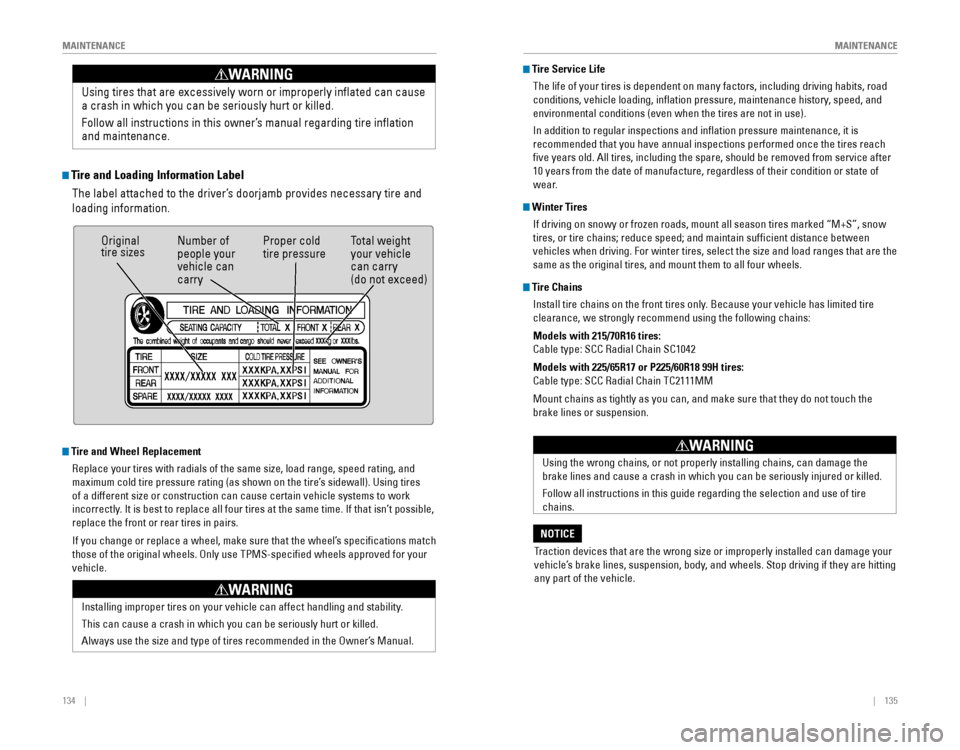
134‚ÄÇ‚ÄÇ‚ÄÇ‚ÄÇ|| 135
MAINTENANCE
MAINTENANCE
Tire and Loading Information Label
The label attached to the driver’s doorjamb provides necessary tire and 
loading information. Using tires that are excessively worn or improperly inflated can cause\
a‚ÄÇcrash‚ÄÇin‚ÄÇwhich‚ÄÇyou‚ÄÇcan‚ÄÇbe‚ÄÇseriously‚ÄÇhurt‚ÄÇor‚ÄÇkilled.
Follow all instructions in this owner’s manual regarding tire inflation
and maintenance
.
WARNING
Original tire‚ÄÇsizesNumber‚ÄÇof‚ÄÇ
people your
vehicle can
carry
Proper cold
tire pressure
Total weight
your vehicle
can carry
(do not exceed)
Tire and Wheel Replacement
Replace‚ÄÇyour‚ÄÇtires‚ÄÇwith‚ÄÇradials‚ÄÇof‚ÄÇthe‚ÄÇsame‚ÄÇsize,‚ÄÇload‚ÄÇrange,‚ÄÇspeed‚ÄÇrating,‚ÄÇand‚ÄÇ
maximum cold tire pressure rating (as shown on the tire’s sidewall). Using tires
of‚ÄÇa‚ÄÇdifferent‚ÄÇsize‚ÄÇor‚ÄÇconstruction‚ÄÇcan‚ÄÇcause‚ÄÇcertain‚ÄÇvehicle‚ÄÇsystems‚ÄÇto‚ÄÇwork‚ÄÇ
incorrectly. It is best to replace all four tires at the same time. If that isn’t possible, 
replace the front or rear tires in pairs.
If you change or replace a wheel, make sure that the wheel’s specifications match 
those of the original wheels. Only use TPMS-specified wheels approved \
for your
vehicle.
Installing‚ÄÇimproper‚ÄÇtires‚ÄÇon‚ÄÇyour‚ÄÇvehicle‚ÄÇcan‚ÄÇaffect‚ÄÇhandling‚ÄÇand‚ÄÇstability.
This‚ÄÇcan‚ÄÇcause‚ÄÇa‚ÄÇcrash‚ÄÇin‚ÄÇwhich‚ÄÇyou‚ÄÇcan‚ÄÇbe‚ÄÇseriously‚ÄÇhurt‚ÄÇor‚ÄÇkilled.
Always use the size and type of tires recommended in the Owner’s Manual.
WARNING
Tire Service Life
The‚ÄÇlife‚ÄÇof‚ÄÇyour‚ÄÇtires‚ÄÇis‚ÄÇdependent‚ÄÇon‚ÄÇmany‚ÄÇfactors,‚ÄÇincluding‚ÄÇdriving‚ÄÇhabits,‚ÄÇroad‚ÄÇ
conditions, vehicle loading, inflation pressure, maintenance history, speed, and
environmental conditions (even when the tires are not in use).
In‚ÄÇaddition‚ÄÇto‚ÄÇregular‚ÄÇinspections‚ÄÇand‚ÄÇinflation‚ÄÇpressure‚ÄÇmaintenance,‚ÄÇit‚ÄÇis‚ÄÇ
recommended that you have annual inspections performed once the tires re\
ach
five‚ÄÇyears‚ÄÇold.‚ÄÇAll‚ÄÇtires,‚ÄÇincluding‚ÄÇthe‚ÄÇspare,‚ÄÇshould‚ÄÇbe‚ÄÇremoved‚ÄÇfrom‚ÄÇservice‚ÄÇafter‚ÄÇ
10 years from the date of manufacture, regardless of their condition or \
state of
wear.
Winter Tires
If driving on snowy or frozen roads, mount all season tires marked “M+S”, snow 
tires,‚ÄÇor‚ÄÇtire‚ÄÇchains;‚ÄÇreduce‚ÄÇspeed;‚ÄÇand‚ÄÇmaintain‚ÄÇsufficient‚ÄÇdistance‚ÄÇbetween‚ÄÇ
vehicles‚ÄÇwhen‚ÄÇdriving.‚ÄÇFor‚ÄÇwinter‚ÄÇtires,‚ÄÇselect‚ÄÇthe‚ÄÇsize‚ÄÇand‚ÄÇload‚ÄÇranges‚ÄÇthat‚ÄÇare‚ÄÇthe‚ÄÇ
same as the original tires, and mount them to all four wheels.
Tire Chains
Install‚ÄÇtire‚ÄÇchains‚ÄÇon‚ÄÇthe‚ÄÇfront‚ÄÇtires‚ÄÇonly.‚ÄÇBecause‚ÄÇyour‚ÄÇvehicle‚ÄÇhas‚ÄÇlimited‚ÄÇtire‚ÄÇ
clearance, we strongly recommend using the following chains:
Models with 215/70R16 tires:
Cable‚ÄÇtype:‚ÄÇSCC‚ÄÇRadial‚ÄÇChain‚ÄÇSC1042
Models with 225/65R17 or P225/60R18 99H tires:
Cable‚ÄÇtype:‚ÄÇSCC‚ÄÇRadial‚ÄÇChain‚ÄÇTC2111MM
Mount chains as tightly as you can, and make sure that they do not touch\
the
brake‚ÄÇlines‚ÄÇor‚ÄÇsuspension.
Traction‚ÄÇdevices‚ÄÇthat‚ÄÇare‚ÄÇthe‚ÄÇwrong‚ÄÇsize‚ÄÇor‚ÄÇimproperly‚ÄÇinstalled‚ÄÇcan‚ÄÇdamage‚ÄÇyour‚ÄÇ
vehicle’s brake lines, suspension, body, and wheels. Stop driving if they are hitting 
any part of the vehicle.
NOTICEUsing the wrong chains, or not properly installing chains, can damage th\
e
brake‚ÄÇlines‚ÄÇand‚ÄÇcause‚ÄÇa‚ÄÇcrash‚ÄÇin‚ÄÇwhich‚ÄÇyou‚ÄÇcan‚ÄÇbe‚ÄÇseriously‚ÄÇinjured‚ÄÇor‚ÄÇkilled.
Follow all instructions in this guide regarding the selection and use of\
tire
chains.
WARNING
Page 80 of 80

152 || 153
INDEX
INDEX
Street Address ..............................................88Traffic .............................................................91Turn-by-Turn‚ÄÇDirections ..............................90
Voice Prompt ................................................. 87
Voice Recognition Tips
................................87
Navigation Commands ..................................144
One-Touch Turn Signal ....................................40On/Off‚ÄÇIndicators ..............................................27
On-screen Commands ...................................149
Opening the Hood
..........................................126
Overheating ..................................................... 113
Pairing a Phone
..........................................75, 80Pandora® .....................................................64, 73Pandora® Commands ....................................148
Parking Brake .............................................26, 99Passenger‚ÄÇAirbag‚ÄÇOff‚ÄÇIndicator .....................12Phone .......................................................75,‚ÄÇ80Phonebook ..................................................76,‚ÄÇ81Phone Commands ..........................................149
Place Category .................................................89Power‚ÄÇDoor‚ÄÇMirrors......................................... 49
Power Mode .....................................................97
Power Moonroof ..............................................38
Power sliding doors .........................................25
Power tailgate ............................................25, 36
Power Windows ...............................................37Radio .......................................................59,‚ÄÇ67Rain-Sensing Wipers ....................................... 42
Readiness Codes ............................................ 139
Rear Camera
...................................................108
Rear Seats .........................................................47
Rearview Mirror ...............................................49
Rear Wiper ........................................................42
Refueling .......................................................... 110
Remote Battery Strength
..............................111
Remote Transmitter .........................................32Reporting‚ÄÇSafety‚ÄÇDefects................................ 23
Roadside Assistance .....................................143
Route Commands ...........................................146Routing .............................................................90Safety‚ÄÇInformation .............................................3Carbon‚ÄÇMonoxide‚ÄÇGas ...................................4
Child Safety ...................................................15Handling‚ÄÇInformation .....................................4Reporting‚ÄÇSafety‚ÄÇDefects ............................23Safety‚ÄÇLabel‚ÄÇLocations ................................22
Safety Messages ...........................................3
Seat Belts ............................................................5
Fastening a Seat Belt ....................................7Lap/Shoulder‚ÄÇSeat‚ÄÇBelts ...............................5Seat‚ÄÇBelt‚ÄÇInspection ......................................6Seat‚ÄÇbelt‚ÄÇreminder .......................................26Seat‚ÄÇBelt‚ÄÇwith‚ÄÇDetachable‚ÄÇAnchor .............8
Shoulder Anchor ............................................7
Seat Heaters .....................................................53
Seats .............................................................43Select/reset‚ÄÇknob .............................................28SEL/RESET‚ÄÇbutton ............................................29
Service Codes ................................................. 125
Settings .......................................................30, 31
Setting the Clock ..............................................54Shifting .............................................................98Shift‚ÄÇLever‚ÄÇDoes‚ÄÇNot‚ÄÇMove ..........................111
Shoulder Anchor ................................................7Side‚ÄÇAirbags...................................................... 10Side‚ÄÇCurtain‚ÄÇAirbags........................................10
Siri® Eyes Free ..................................................84
SiriusXM® Radio .............................................68
SiriusXM® Radio Commands ......................148Smart Entry System ...................................25, 33
SMS Text Messaging ................................77,‚ÄÇ83Sound .............................................................57
Specifications .................................................140Speed‚ÄÇDial ...................................................76,‚ÄÇ82Starter system ..................................................25
Steering Wheel ................................................. 48
Steering‚ÄÇWheel‚ÄÇand‚ÄÇNearby‚ÄÇControls ............1
Steering Wheel Controls ...........................56, 85
Street Address .................................................. 88
Supplemental Restraint System (SRS)
...11,‚ÄÇ24System message ..............................................26Tailgate .......................................................33, 35
Tailgate open ....................................................26
Talk Button Tips ..........................................79,‚ÄÇ87Text Messaging ..........................................77,‚ÄÇ83Tire‚ÄÇInformation ..............................................133DOT‚ÄÇTire‚ÄÇQuality‚ÄÇGrading ..........................137Inflation‚ÄÇGuidelines ....................................133Tire‚ÄÇand‚ÄÇLoading‚ÄÇInformation‚ÄÇLabel ........134
Tire and Wheel Replacement ...................134
Tire Chains ...................................................135Tire‚ÄÇIdentification‚ÄÇNumber‚ÄÇ(TIN) ..............136Tire‚ÄÇLabeling ................................................136
Tire Service Life ..........................................135
Tire Terminology .........................................136Wear‚ÄÇIndicators .........................................133
Winter Tires .................................................135
Tire Pressure Monitoring System (TPMS)
.......................................25, 115Tires ...........................................................140
Touchscreen Operation ..................................65Towing ...........................................................114
Towing a Trailer ................................................96Traffic .............................................................91
Troubleshooting ..............................................141Turn-by-Turn‚ÄÇDirections ..................................90
Turn signal ...................................................27,‚ÄÇ40Under the Hood ..............................................126USB‚ÄÇAdapter‚ÄÇCable ..........................................55
USB Commands .............................................. 148
USB‚ÄÇFlash‚ÄÇDrive..........................................62,‚ÄÇ71USB Port ............................................................55Vehicle ...........................................................140
Vehicle Controls ...............................................32Vehicle Stability Assist (VSA®) ........25, 27, 100Visual Index......................................................... 1Voice Command Index ..................................144
Voice Prompt ....................................................87
Warranty Coverages .....................................143Wear‚ÄÇIndicators .............................................133
Window Washer Fluid ...................................130
Windows ............................................................ 37
Winter Tires
.....................................................135
Wiper Blades ..................................................131
Wiper Operation ...............................................41